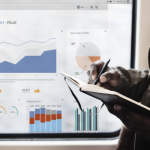As a data analyst, you play a crucial role in analyzing and interpreting data to drive informed decision-making. With advancements in artificial intelligence, ChatGPT has emerged as a powerful tool that can augment your analytical capabilities and help you derive deeper insights from your data. In this comprehensive guide, we will explore how you can leverage this AI-powered chatbot to enhance your data analysis skills and take your work to new heights.
Table of Contents
Understanding the Basics of ChatGPT
ChatGPT, developed by OpenAI, is an advanced language model that uses deep learning techniques to understand and generate human-like text. It is trained on vast amounts of data and can generate responses based on the context provided. The model has been trained to understand and respond to a wide range of queries and can be a valuable asset in your data analysis journey.
Integrating ChatGPT into your Data Analysis Workflow
1. Preparing Data for Analysis
ChatGPT can assist in automating these tasks by helping you identify and handle missing values and outliers in your dataset. With its natural language processing capabilities, ChatGPT can understand the context of your data and provide valuable suggestions for data cleaning and preprocessing.
2. Exploratory Data Analysis (EDA)
Exploratory Data Analysis involves uncovering patterns, trends, and relationships within the data. ChatGPT can assist you in this process by generating descriptive statistics and visualizations based on the provided data. By interacting with this AI-powered chatbot, you can gain new perspectives and insights into your data, leading to a more comprehensive analysis.
3. Feature Engineering
ChatGPT can generate new features based on the context and characteristics of your data. By incorporating these generated features into your analysis, you can enhance the predictive power of your models and uncover hidden patterns that may have been overlooked.
4. Model Selection and Training
Choosing the right machine learning algorithms and training models are critical steps in data analysis. ChatGPT can assist you in this process by providing recommendations based on the characteristics of your dataset. Additionally, ChatGPT can help with hyperparameter optimization, enabling you to fine-tune your models for better performance.
5. Model Evaluation and Validation
Once you have trained your models, evaluating their performance and validating their results are essential. ChatGPT can assist in assessing model performance through various techniques, including cross-validation. Additionally, it can help interpret model outputs, providing insights into the significance of different features and variables.
Advanced Techniques with ChatGPT for Data Analysis
1. Natural Language Processing (NLP) Tasks
ChatGPT’s natural language processing capabilities extend beyond basic analysis. It can assist in performing tasks such as sentiment analysis, text classification, and named entity recognition. By utilizing it, you can gain a deeper understanding of textual data and extract valuable insights for various applications.
2. Time Series Analysis
Analyzing time series data requires specialized techniques. ChatGPT can be trained to forecast future values, detect seasonality and trends, and identify anomalies within time series data. By leveraging its capabilities, you can improve your forecasting accuracy and identify critical patterns in your time-dependent datasets.
3. Dimensionality Reduction and Clustering
High-dimensional datasets can pose challenges in data analysis. ChatGPT can help overcome this by employing dimensionality reduction techniques such as Principal Component Analysis (PCA). Additionally, it can assist in clustering analysis, enabling you to identify groups and patterns within your data.
4. Reinforcement Learning for Decision-Making
Reinforcement learning algorithms can optimize decision-making processes. ChatGPT can be utilized to explore and implement reinforcement learning techniques, improving the efficiency and effectiveness of decision-making in various domains. By incorporating ChatGPT, you can enhance your decision-making capabilities and drive better outcomes.
Best Practices and Tips for Effective Data Analysis with ChatGPT
1. Ensuring Data Privacy and Security
Ensure that sensitive data is handled responsibly and take necessary precautions to protect user information.
2. Handling Bias and Ethical Considerations
AI models like ChatGPT can inherit biases present in the training data. It is essential to be aware of these biases and take steps to mitigate their impact. Regularly evaluate and address any potential ethical concerns arising from the use of AI in data analysis.
3. Leveraging Transfer Learning for Faster Analysis
Transfer learning allows you to use pre-trained models and fine-tune them for specific tasks. By leveraging pre-trained ChatGPT models, you can expedite your data analysis workflow and achieve faster results.
4. Staying Up to Date with ChatGPT
Stay informed about the latest developments, updates, and best practices related to ChatGPT and AI in data analysis. Engage with the community to learn from other’s experiences and share your insights.
Summing Up
ChatGPT, equipped with its natural language processing capabilities, serves as a formidable tool for data analysts. By harnessing the conversational abilities of this AI chatbot and posing the right prompts, analysts can extract invaluable insights, troubleshoot challenges, decipher intricate code, generate code snippets, acquire new skills, and streamline documentation processes.
As you embark on the journey of exploring and incorporating this innovative technology into your workflow, always rely on your professional judgment and expertise. Embrace the boundless potential offered by ChatGPT and allow it to elevate your data analysis endeavors.












